The Role of Reversal Theory in Modern Digital Advertising Campaigns
VerifiedAdded on 2023/06/03
|24
|7684
|124
Report
AI Summary
This report delves into the application of Reversal Theory within the realm of digital advertising, examining how consumers' metamotivational states, such as telic (serious-minded) and paratelic (playful-minded), influence their online interactions. It explores the theory's relevance to interactive advertising, identifying factors that cause shifts in these states, including contingency, frustration, and satiation. The report reviews existing literature from a Reversal Theory perspective, highlighting the importance of understanding these fluctuations to enhance the effectiveness of digital marketing campaigns. It discusses the implications of these states on consumer behavior, the dynamics of state dominance and balance, and suggests avenues for future research in the field. The analysis underscores the importance of considering consumer characteristics and motivations to design more persuasive and engaging digital advertisements. The report also discusses the use of interactive marketing tools and the impact of digital media on consumer behavior.
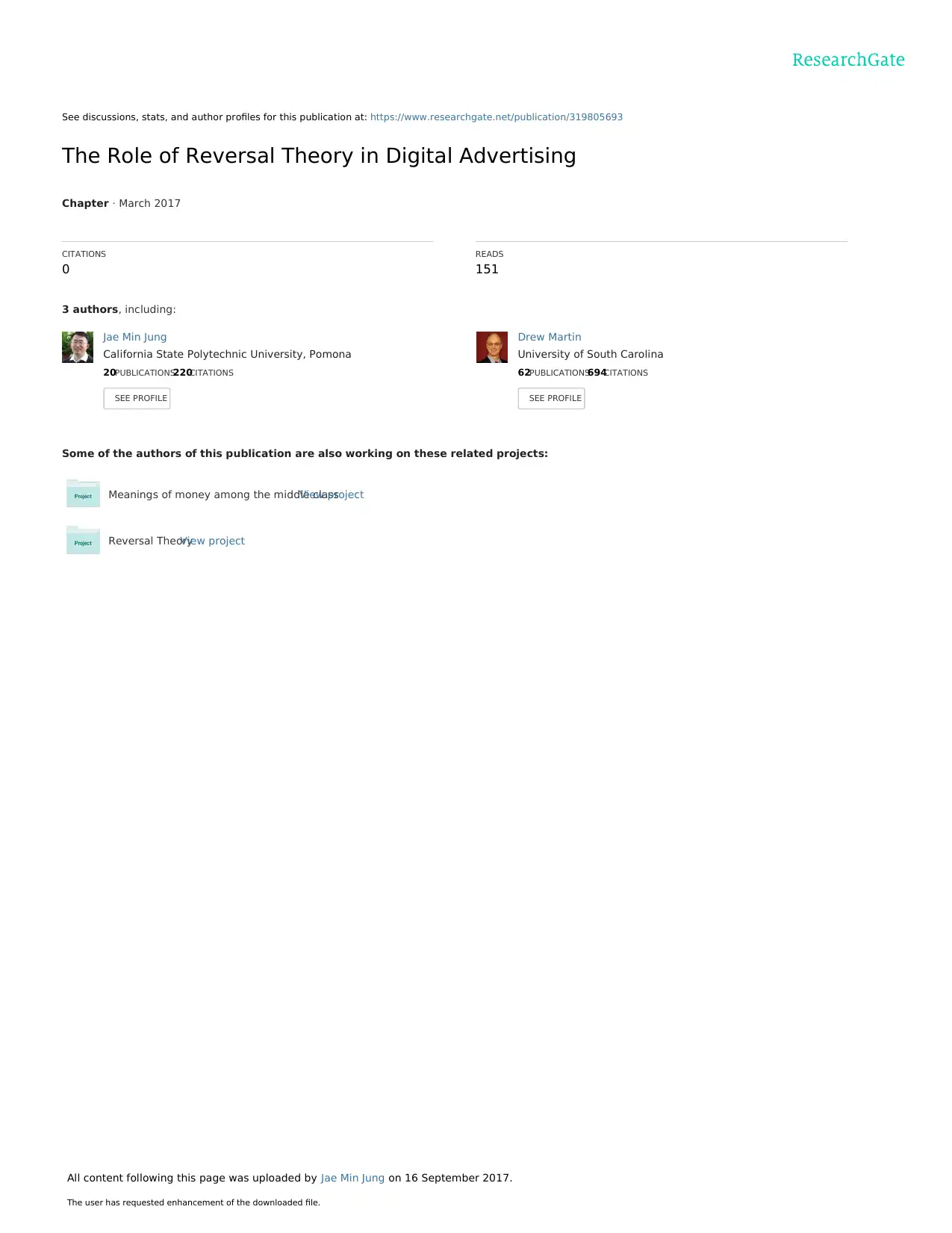
See discussions, stats, and author profiles for this publication at: https://www.researchgate.net/publication/319805693
The Role of Reversal Theory in Digital Advertising
Chapter · March 2017
CITATIONS
0
READS
151
3 authors, including:
Some of the authors of this publication are also working on these related projects:
Meanings of money among the middle classView project
Reversal TheoryView project
Jae Min Jung
California State Polytechnic University, Pomona
20PUBLICATIONS220CITATIONS
SEE PROFILE
Drew Martin
University of South Carolina
62PUBLICATIONS694CITATIONS
SEE PROFILE
All content following this page was uploaded by Jae Min Jung on 16 September 2017.
The user has requested enhancement of the downloaded file.
The Role of Reversal Theory in Digital Advertising
Chapter · March 2017
CITATIONS
0
READS
151
3 authors, including:
Some of the authors of this publication are also working on these related projects:
Meanings of money among the middle classView project
Reversal TheoryView project
Jae Min Jung
California State Polytechnic University, Pomona
20PUBLICATIONS220CITATIONS
SEE PROFILE
Drew Martin
University of South Carolina
62PUBLICATIONS694CITATIONS
SEE PROFILE
All content following this page was uploaded by Jae Min Jung on 16 September 2017.
The user has requested enhancement of the downloaded file.
Paraphrase This Document
Need a fresh take? Get an instant paraphrase of this document with our AI Paraphraser
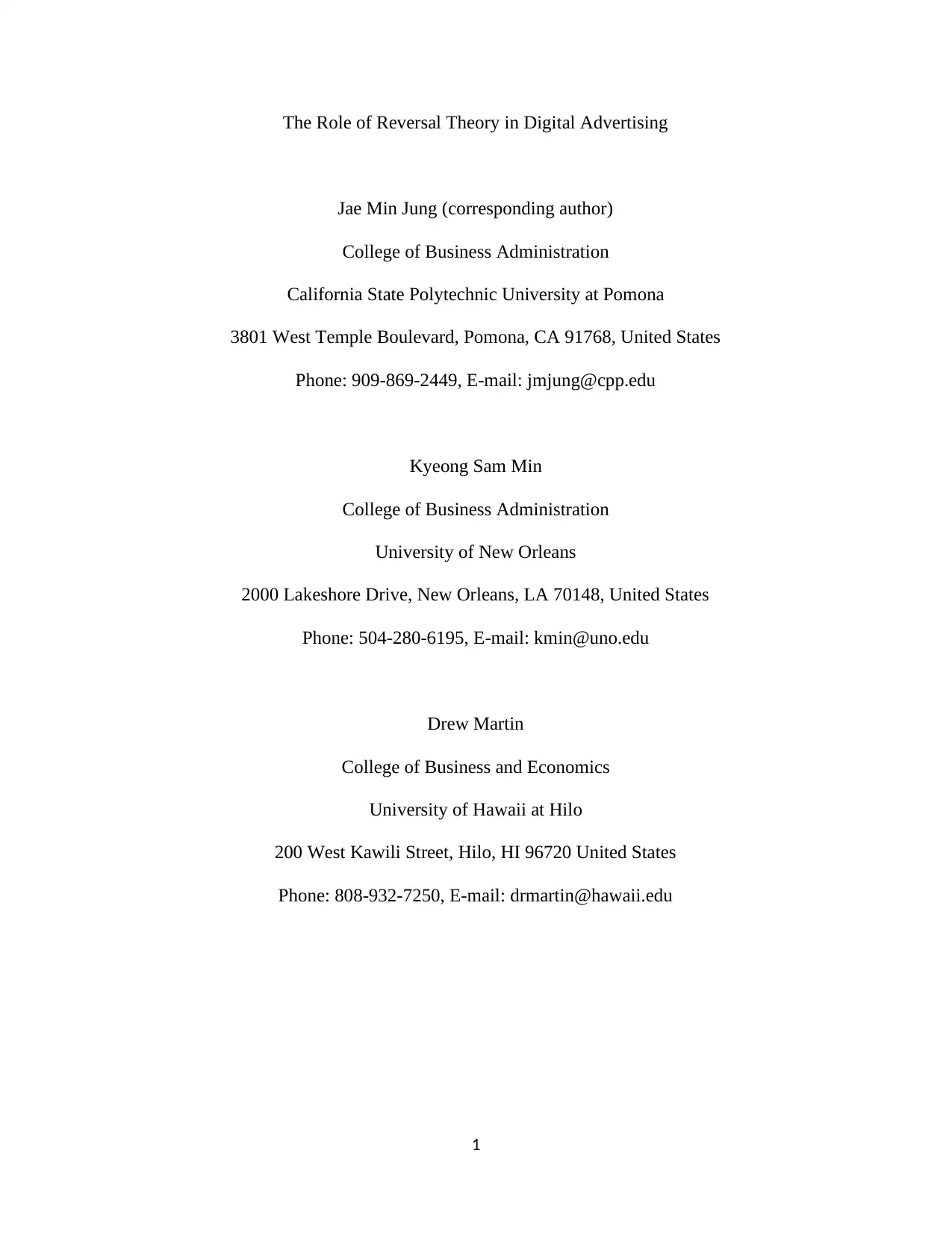
The Role of Reversal Theory in Digital Advertising
Jae Min Jung (corresponding author)
College of Business Administration
California State Polytechnic University at Pomona
3801 West Temple Boulevard, Pomona, CA 91768, United States
Phone: 909-869-2449, E-mail: jmjung@cpp.edu
Kyeong Sam Min
College of Business Administration
University of New Orleans
2000 Lakeshore Drive, New Orleans, LA 70148, United States
Phone: 504-280-6195, E-mail: kmin@uno.edu
Drew Martin
College of Business and Economics
University of Hawaii at Hilo
200 West Kawili Street, Hilo, HI 96720 United States
Phone: 808-932-7250, E-mail: drmartin@hawaii.edu
1
Jae Min Jung (corresponding author)
College of Business Administration
California State Polytechnic University at Pomona
3801 West Temple Boulevard, Pomona, CA 91768, United States
Phone: 909-869-2449, E-mail: jmjung@cpp.edu
Kyeong Sam Min
College of Business Administration
University of New Orleans
2000 Lakeshore Drive, New Orleans, LA 70148, United States
Phone: 504-280-6195, E-mail: kmin@uno.edu
Drew Martin
College of Business and Economics
University of Hawaii at Hilo
200 West Kawili Street, Hilo, HI 96720 United States
Phone: 808-932-7250, E-mail: drmartin@hawaii.edu
1
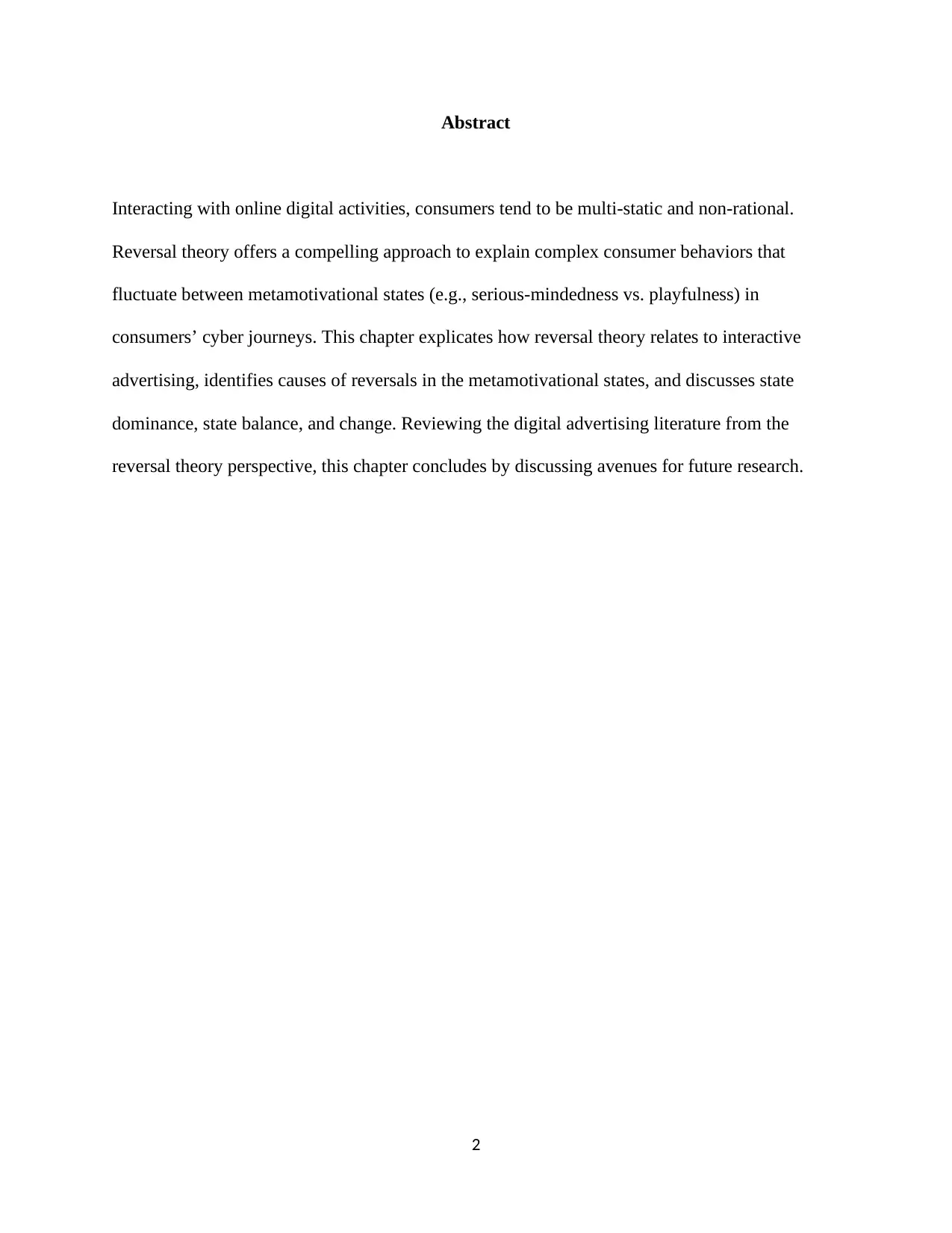
Abstract
Interacting with online digital activities, consumers tend to be multi-static and non-rational.
Reversal theory offers a compelling approach to explain complex consumer behaviors that
fluctuate between metamotivational states (e.g., serious-mindedness vs. playfulness) in
consumers’ cyber journeys. This chapter explicates how reversal theory relates to interactive
advertising, identifies causes of reversals in the metamotivational states, and discusses state
dominance, state balance, and change. Reviewing the digital advertising literature from the
reversal theory perspective, this chapter concludes by discussing avenues for future research.
2
Interacting with online digital activities, consumers tend to be multi-static and non-rational.
Reversal theory offers a compelling approach to explain complex consumer behaviors that
fluctuate between metamotivational states (e.g., serious-mindedness vs. playfulness) in
consumers’ cyber journeys. This chapter explicates how reversal theory relates to interactive
advertising, identifies causes of reversals in the metamotivational states, and discusses state
dominance, state balance, and change. Reviewing the digital advertising literature from the
reversal theory perspective, this chapter concludes by discussing avenues for future research.
2
⊘ This is a preview!⊘
Do you want full access?
Subscribe today to unlock all pages.

Trusted by 1+ million students worldwide

Inevitably companies increasingly use interactive marketing tools to engage customers
and remain relevant in the market place (Rodriguez, Dixon, & Peltier, 2014; Stone & Woodcock,
2013). As the prevalence of the Internet and digital media ushers in the era of unprecedented
two-way communications between companies and consumers, the value of popular web sites that
provide interactive features has skyrocketed (Jung, Hui, Min, & Martin, 2014). At the heart of
interactive marketing is digital advertising. This chapter introduces a relatively under-researched
theory called reversal theory (Apter, 2007, 2015) that offers promising utility in understanding
consumer behavior (Cummins, Peltier, Schibrowsky, & Nill, 2013) in the era of social media and
digital marketing.
While much research demonstrates that interactive advertisements are effective (Kim &
Forsythe, 2008; Köhler, Rohm, de Ruyter, & Wetzels, 2011), relatively little attention identifies
the conditions under which the interactivity may harm persuasion (Jung, Min, & Kellaris, 2011;
Schlosser, 2003; Seyedghorban, Tahernejad, & Matanda, 2016). For instance, Schlosser (2003)
finds that interactivity is effective for casual Internet browsers, who do not have specific goals in
mind, but that it is ineffective for searchers, who have specific goals. Jung et al. (2011) further
advance the notion of contingency to the game advertising. Specifically, they find that for casual
Internet browsers, interactivity enhances persuasion regardless of the user’s need for cognitive
closure. For information searchers, interactivity’s persuasive effect is contingent upon the
searchers’ need for cognitive closure. Under high need for cognitive closure, the interactivity
tends to harm persuasion for searchers (see Schlosser, 2003); however, under low level of need
for cognitive closure, the interactivity still facilitates persuasion even for searchers. Thus, Jung et
al. (2011) show that consumer characteristics, such as the need for cognitive closure, can
3
and remain relevant in the market place (Rodriguez, Dixon, & Peltier, 2014; Stone & Woodcock,
2013). As the prevalence of the Internet and digital media ushers in the era of unprecedented
two-way communications between companies and consumers, the value of popular web sites that
provide interactive features has skyrocketed (Jung, Hui, Min, & Martin, 2014). At the heart of
interactive marketing is digital advertising. This chapter introduces a relatively under-researched
theory called reversal theory (Apter, 2007, 2015) that offers promising utility in understanding
consumer behavior (Cummins, Peltier, Schibrowsky, & Nill, 2013) in the era of social media and
digital marketing.
While much research demonstrates that interactive advertisements are effective (Kim &
Forsythe, 2008; Köhler, Rohm, de Ruyter, & Wetzels, 2011), relatively little attention identifies
the conditions under which the interactivity may harm persuasion (Jung, Min, & Kellaris, 2011;
Schlosser, 2003; Seyedghorban, Tahernejad, & Matanda, 2016). For instance, Schlosser (2003)
finds that interactivity is effective for casual Internet browsers, who do not have specific goals in
mind, but that it is ineffective for searchers, who have specific goals. Jung et al. (2011) further
advance the notion of contingency to the game advertising. Specifically, they find that for casual
Internet browsers, interactivity enhances persuasion regardless of the user’s need for cognitive
closure. For information searchers, interactivity’s persuasive effect is contingent upon the
searchers’ need for cognitive closure. Under high need for cognitive closure, the interactivity
tends to harm persuasion for searchers (see Schlosser, 2003); however, under low level of need
for cognitive closure, the interactivity still facilitates persuasion even for searchers. Thus, Jung et
al. (2011) show that consumer characteristics, such as the need for cognitive closure, can
3
Paraphrase This Document
Need a fresh take? Get an instant paraphrase of this document with our AI Paraphraser
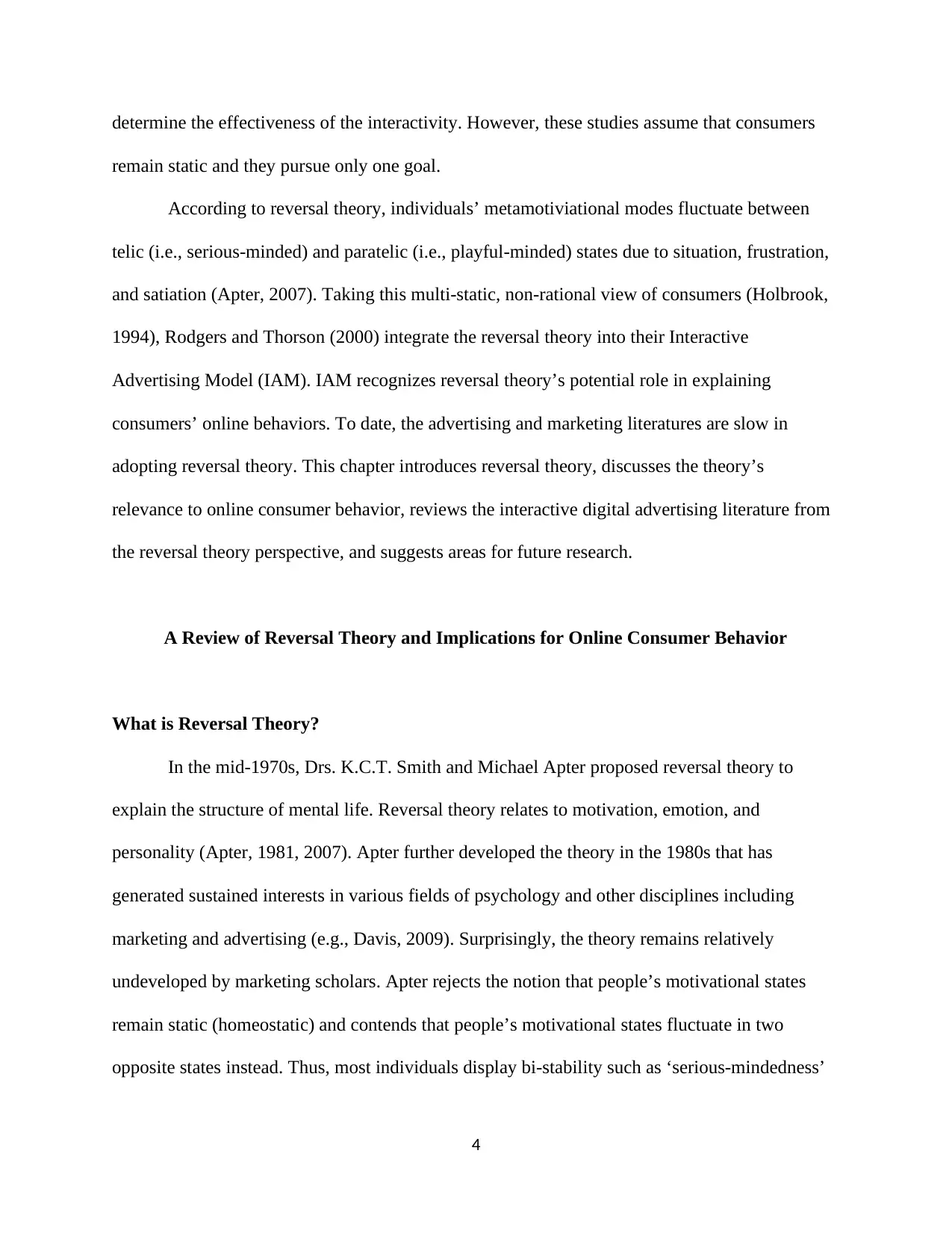
determine the effectiveness of the interactivity. However, these studies assume that consumers
remain static and they pursue only one goal.
According to reversal theory, individuals’ metamotiviational modes fluctuate between
telic (i.e., serious-minded) and paratelic (i.e., playful-minded) states due to situation, frustration,
and satiation (Apter, 2007). Taking this multi-static, non-rational view of consumers (Holbrook,
1994), Rodgers and Thorson (2000) integrate the reversal theory into their Interactive
Advertising Model (IAM). IAM recognizes reversal theory’s potential role in explaining
consumers’ online behaviors. To date, the advertising and marketing literatures are slow in
adopting reversal theory. This chapter introduces reversal theory, discusses the theory’s
relevance to online consumer behavior, reviews the interactive digital advertising literature from
the reversal theory perspective, and suggests areas for future research.
A Review of Reversal Theory and Implications for Online Consumer Behavior
What is Reversal Theory?
In the mid-1970s, Drs. K.C.T. Smith and Michael Apter proposed reversal theory to
explain the structure of mental life. Reversal theory relates to motivation, emotion, and
personality (Apter, 1981, 2007). Apter further developed the theory in the 1980s that has
generated sustained interests in various fields of psychology and other disciplines including
marketing and advertising (e.g., Davis, 2009). Surprisingly, the theory remains relatively
undeveloped by marketing scholars. Apter rejects the notion that people’s motivational states
remain static (homeostatic) and contends that people’s motivational states fluctuate in two
opposite states instead. Thus, most individuals display bi-stability such as ‘serious-mindedness’
4
remain static and they pursue only one goal.
According to reversal theory, individuals’ metamotiviational modes fluctuate between
telic (i.e., serious-minded) and paratelic (i.e., playful-minded) states due to situation, frustration,
and satiation (Apter, 2007). Taking this multi-static, non-rational view of consumers (Holbrook,
1994), Rodgers and Thorson (2000) integrate the reversal theory into their Interactive
Advertising Model (IAM). IAM recognizes reversal theory’s potential role in explaining
consumers’ online behaviors. To date, the advertising and marketing literatures are slow in
adopting reversal theory. This chapter introduces reversal theory, discusses the theory’s
relevance to online consumer behavior, reviews the interactive digital advertising literature from
the reversal theory perspective, and suggests areas for future research.
A Review of Reversal Theory and Implications for Online Consumer Behavior
What is Reversal Theory?
In the mid-1970s, Drs. K.C.T. Smith and Michael Apter proposed reversal theory to
explain the structure of mental life. Reversal theory relates to motivation, emotion, and
personality (Apter, 1981, 2007). Apter further developed the theory in the 1980s that has
generated sustained interests in various fields of psychology and other disciplines including
marketing and advertising (e.g., Davis, 2009). Surprisingly, the theory remains relatively
undeveloped by marketing scholars. Apter rejects the notion that people’s motivational states
remain static (homeostatic) and contends that people’s motivational states fluctuate in two
opposite states instead. Thus, most individuals display bi-stability such as ‘serious-mindedness’
4
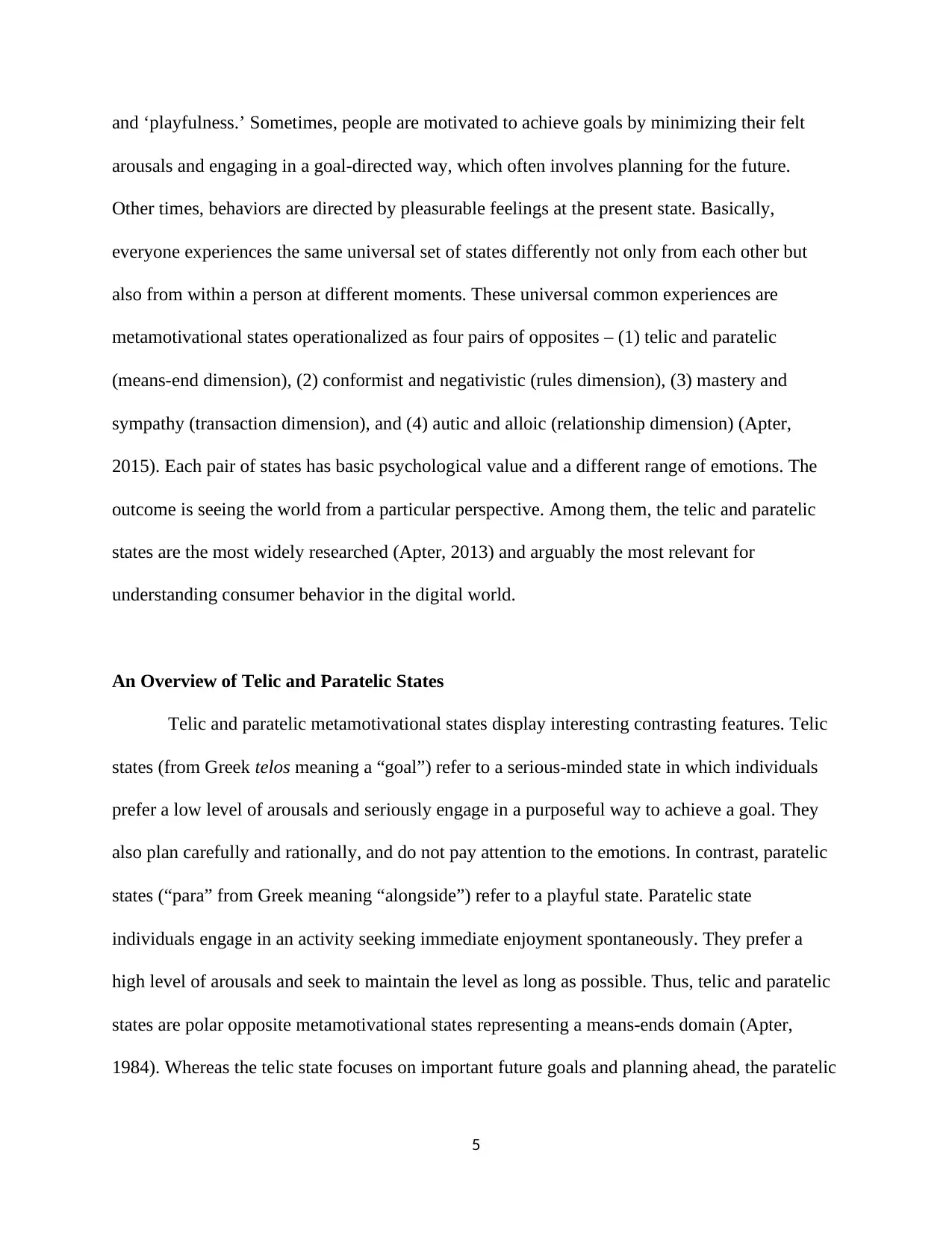
and ‘playfulness.’ Sometimes, people are motivated to achieve goals by minimizing their felt
arousals and engaging in a goal-directed way, which often involves planning for the future.
Other times, behaviors are directed by pleasurable feelings at the present state. Basically,
everyone experiences the same universal set of states differently not only from each other but
also from within a person at different moments. These universal common experiences are
metamotivational states operationalized as four pairs of opposites – (1) telic and paratelic
(means-end dimension), (2) conformist and negativistic (rules dimension), (3) mastery and
sympathy (transaction dimension), and (4) autic and alloic (relationship dimension) (Apter,
2015). Each pair of states has basic psychological value and a different range of emotions. The
outcome is seeing the world from a particular perspective. Among them, the telic and paratelic
states are the most widely researched (Apter, 2013) and arguably the most relevant for
understanding consumer behavior in the digital world.
An Overview of Telic and Paratelic States
Telic and paratelic metamotivational states display interesting contrasting features. Telic
states (from Greek telos meaning a “goal”) refer to a serious-minded state in which individuals
prefer a low level of arousals and seriously engage in a purposeful way to achieve a goal. They
also plan carefully and rationally, and do not pay attention to the emotions. In contrast, paratelic
states (“para” from Greek meaning “alongside”) refer to a playful state. Paratelic state
individuals engage in an activity seeking immediate enjoyment spontaneously. They prefer a
high level of arousals and seek to maintain the level as long as possible. Thus, telic and paratelic
states are polar opposite metamotivational states representing a means-ends domain (Apter,
1984). Whereas the telic state focuses on important future goals and planning ahead, the paratelic
5
arousals and engaging in a goal-directed way, which often involves planning for the future.
Other times, behaviors are directed by pleasurable feelings at the present state. Basically,
everyone experiences the same universal set of states differently not only from each other but
also from within a person at different moments. These universal common experiences are
metamotivational states operationalized as four pairs of opposites – (1) telic and paratelic
(means-end dimension), (2) conformist and negativistic (rules dimension), (3) mastery and
sympathy (transaction dimension), and (4) autic and alloic (relationship dimension) (Apter,
2015). Each pair of states has basic psychological value and a different range of emotions. The
outcome is seeing the world from a particular perspective. Among them, the telic and paratelic
states are the most widely researched (Apter, 2013) and arguably the most relevant for
understanding consumer behavior in the digital world.
An Overview of Telic and Paratelic States
Telic and paratelic metamotivational states display interesting contrasting features. Telic
states (from Greek telos meaning a “goal”) refer to a serious-minded state in which individuals
prefer a low level of arousals and seriously engage in a purposeful way to achieve a goal. They
also plan carefully and rationally, and do not pay attention to the emotions. In contrast, paratelic
states (“para” from Greek meaning “alongside”) refer to a playful state. Paratelic state
individuals engage in an activity seeking immediate enjoyment spontaneously. They prefer a
high level of arousals and seek to maintain the level as long as possible. Thus, telic and paratelic
states are polar opposite metamotivational states representing a means-ends domain (Apter,
1984). Whereas the telic state focuses on important future goals and planning ahead, the paratelic
5
⊘ This is a preview!⊘
Do you want full access?
Subscribe today to unlock all pages.

Trusted by 1+ million students worldwide
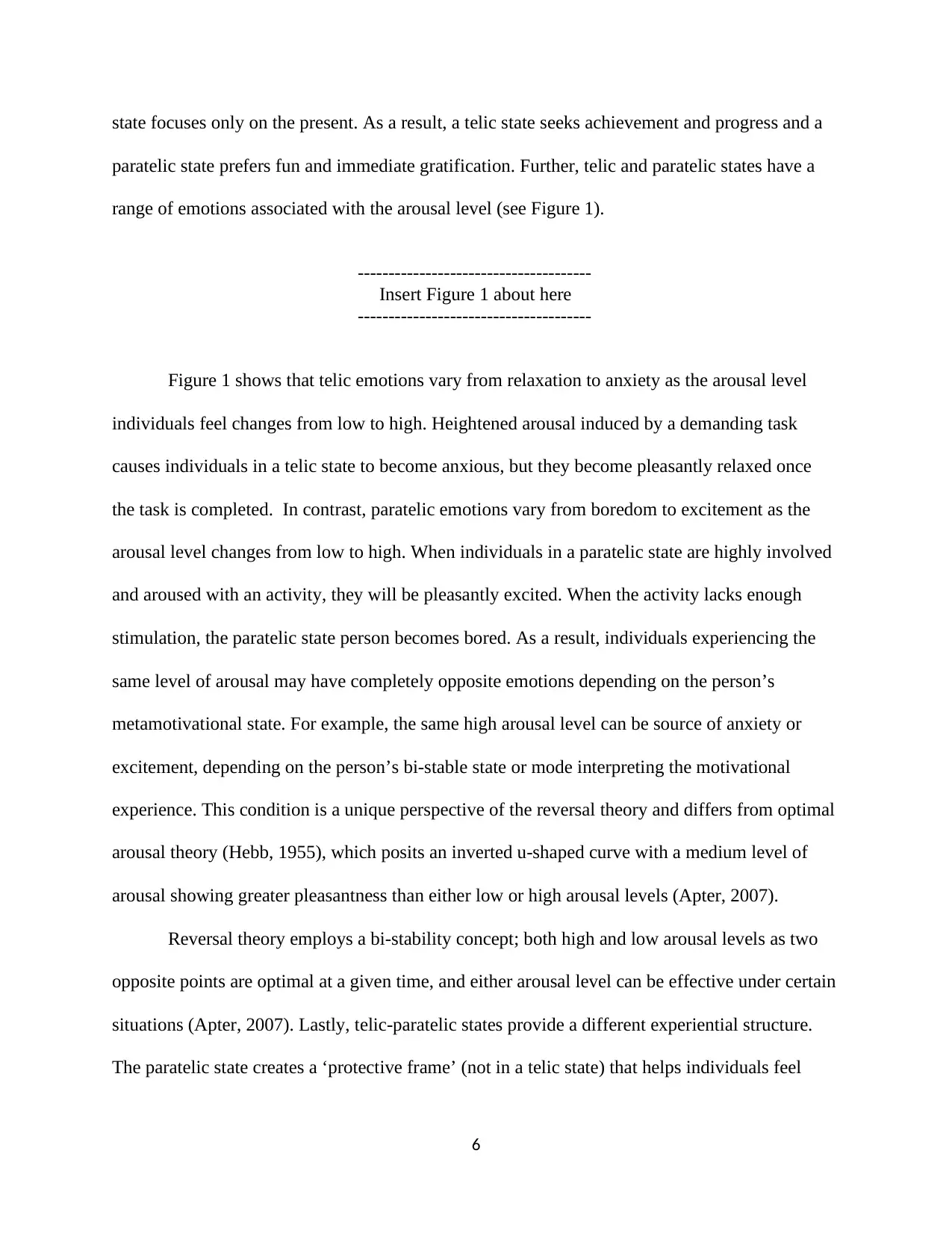
state focuses only on the present. As a result, a telic state seeks achievement and progress and a
paratelic state prefers fun and immediate gratification. Further, telic and paratelic states have a
range of emotions associated with the arousal level (see Figure 1).
--------------------------------------
Insert Figure 1 about here
--------------------------------------
Figure 1 shows that telic emotions vary from relaxation to anxiety as the arousal level
individuals feel changes from low to high. Heightened arousal induced by a demanding task
causes individuals in a telic state to become anxious, but they become pleasantly relaxed once
the task is completed. In contrast, paratelic emotions vary from boredom to excitement as the
arousal level changes from low to high. When individuals in a paratelic state are highly involved
and aroused with an activity, they will be pleasantly excited. When the activity lacks enough
stimulation, the paratelic state person becomes bored. As a result, individuals experiencing the
same level of arousal may have completely opposite emotions depending on the person’s
metamotivational state. For example, the same high arousal level can be source of anxiety or
excitement, depending on the person’s bi-stable state or mode interpreting the motivational
experience. This condition is a unique perspective of the reversal theory and differs from optimal
arousal theory (Hebb, 1955), which posits an inverted u-shaped curve with a medium level of
arousal showing greater pleasantness than either low or high arousal levels (Apter, 2007).
Reversal theory employs a bi-stability concept; both high and low arousal levels as two
opposite points are optimal at a given time, and either arousal level can be effective under certain
situations (Apter, 2007). Lastly, telic-paratelic states provide a different experiential structure.
The paratelic state creates a ‘protective frame’ (not in a telic state) that helps individuals feel
6
paratelic state prefers fun and immediate gratification. Further, telic and paratelic states have a
range of emotions associated with the arousal level (see Figure 1).
--------------------------------------
Insert Figure 1 about here
--------------------------------------
Figure 1 shows that telic emotions vary from relaxation to anxiety as the arousal level
individuals feel changes from low to high. Heightened arousal induced by a demanding task
causes individuals in a telic state to become anxious, but they become pleasantly relaxed once
the task is completed. In contrast, paratelic emotions vary from boredom to excitement as the
arousal level changes from low to high. When individuals in a paratelic state are highly involved
and aroused with an activity, they will be pleasantly excited. When the activity lacks enough
stimulation, the paratelic state person becomes bored. As a result, individuals experiencing the
same level of arousal may have completely opposite emotions depending on the person’s
metamotivational state. For example, the same high arousal level can be source of anxiety or
excitement, depending on the person’s bi-stable state or mode interpreting the motivational
experience. This condition is a unique perspective of the reversal theory and differs from optimal
arousal theory (Hebb, 1955), which posits an inverted u-shaped curve with a medium level of
arousal showing greater pleasantness than either low or high arousal levels (Apter, 2007).
Reversal theory employs a bi-stability concept; both high and low arousal levels as two
opposite points are optimal at a given time, and either arousal level can be effective under certain
situations (Apter, 2007). Lastly, telic-paratelic states provide a different experiential structure.
The paratelic state creates a ‘protective frame’ (not in a telic state) that helps individuals feel
6
Paraphrase This Document
Need a fresh take? Get an instant paraphrase of this document with our AI Paraphraser
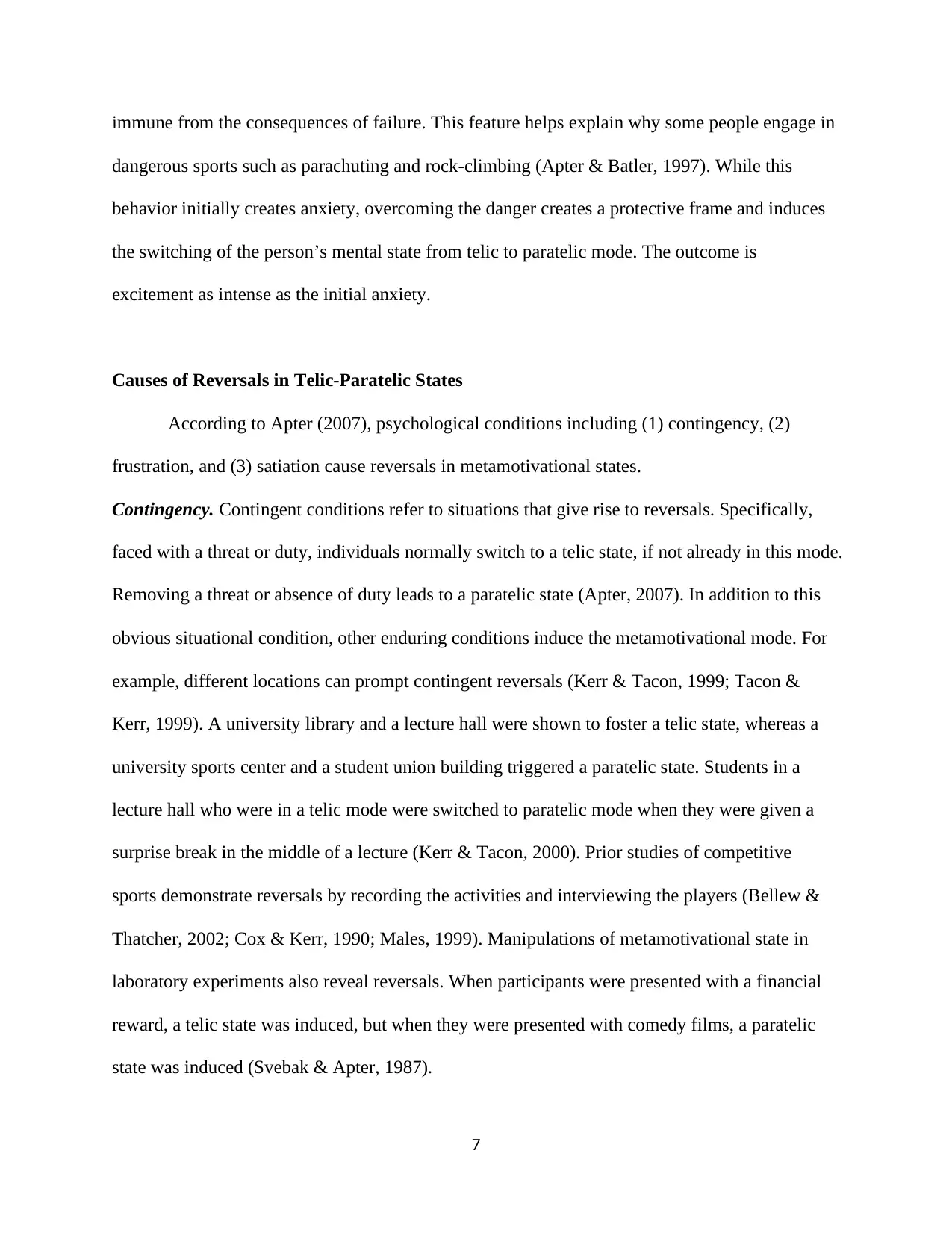
immune from the consequences of failure. This feature helps explain why some people engage in
dangerous sports such as parachuting and rock-climbing (Apter & Batler, 1997). While this
behavior initially creates anxiety, overcoming the danger creates a protective frame and induces
the switching of the person’s mental state from telic to paratelic mode. The outcome is
excitement as intense as the initial anxiety.
Causes of Reversals in Telic-Paratelic States
According to Apter (2007), psychological conditions including (1) contingency, (2)
frustration, and (3) satiation cause reversals in metamotivational states.
Contingency. Contingent conditions refer to situations that give rise to reversals. Specifically,
faced with a threat or duty, individuals normally switch to a telic state, if not already in this mode.
Removing a threat or absence of duty leads to a paratelic state (Apter, 2007). In addition to this
obvious situational condition, other enduring conditions induce the metamotivational mode. For
example, different locations can prompt contingent reversals (Kerr & Tacon, 1999; Tacon &
Kerr, 1999). A university library and a lecture hall were shown to foster a telic state, whereas a
university sports center and a student union building triggered a paratelic state. Students in a
lecture hall who were in a telic mode were switched to paratelic mode when they were given a
surprise break in the middle of a lecture (Kerr & Tacon, 2000). Prior studies of competitive
sports demonstrate reversals by recording the activities and interviewing the players (Bellew &
Thatcher, 2002; Cox & Kerr, 1990; Males, 1999). Manipulations of metamotivational state in
laboratory experiments also reveal reversals. When participants were presented with a financial
reward, a telic state was induced, but when they were presented with comedy films, a paratelic
state was induced (Svebak & Apter, 1987).
7
dangerous sports such as parachuting and rock-climbing (Apter & Batler, 1997). While this
behavior initially creates anxiety, overcoming the danger creates a protective frame and induces
the switching of the person’s mental state from telic to paratelic mode. The outcome is
excitement as intense as the initial anxiety.
Causes of Reversals in Telic-Paratelic States
According to Apter (2007), psychological conditions including (1) contingency, (2)
frustration, and (3) satiation cause reversals in metamotivational states.
Contingency. Contingent conditions refer to situations that give rise to reversals. Specifically,
faced with a threat or duty, individuals normally switch to a telic state, if not already in this mode.
Removing a threat or absence of duty leads to a paratelic state (Apter, 2007). In addition to this
obvious situational condition, other enduring conditions induce the metamotivational mode. For
example, different locations can prompt contingent reversals (Kerr & Tacon, 1999; Tacon &
Kerr, 1999). A university library and a lecture hall were shown to foster a telic state, whereas a
university sports center and a student union building triggered a paratelic state. Students in a
lecture hall who were in a telic mode were switched to paratelic mode when they were given a
surprise break in the middle of a lecture (Kerr & Tacon, 2000). Prior studies of competitive
sports demonstrate reversals by recording the activities and interviewing the players (Bellew &
Thatcher, 2002; Cox & Kerr, 1990; Males, 1999). Manipulations of metamotivational state in
laboratory experiments also reveal reversals. When participants were presented with a financial
reward, a telic state was induced, but when they were presented with comedy films, a paratelic
state was induced (Svebak & Apter, 1987).
7
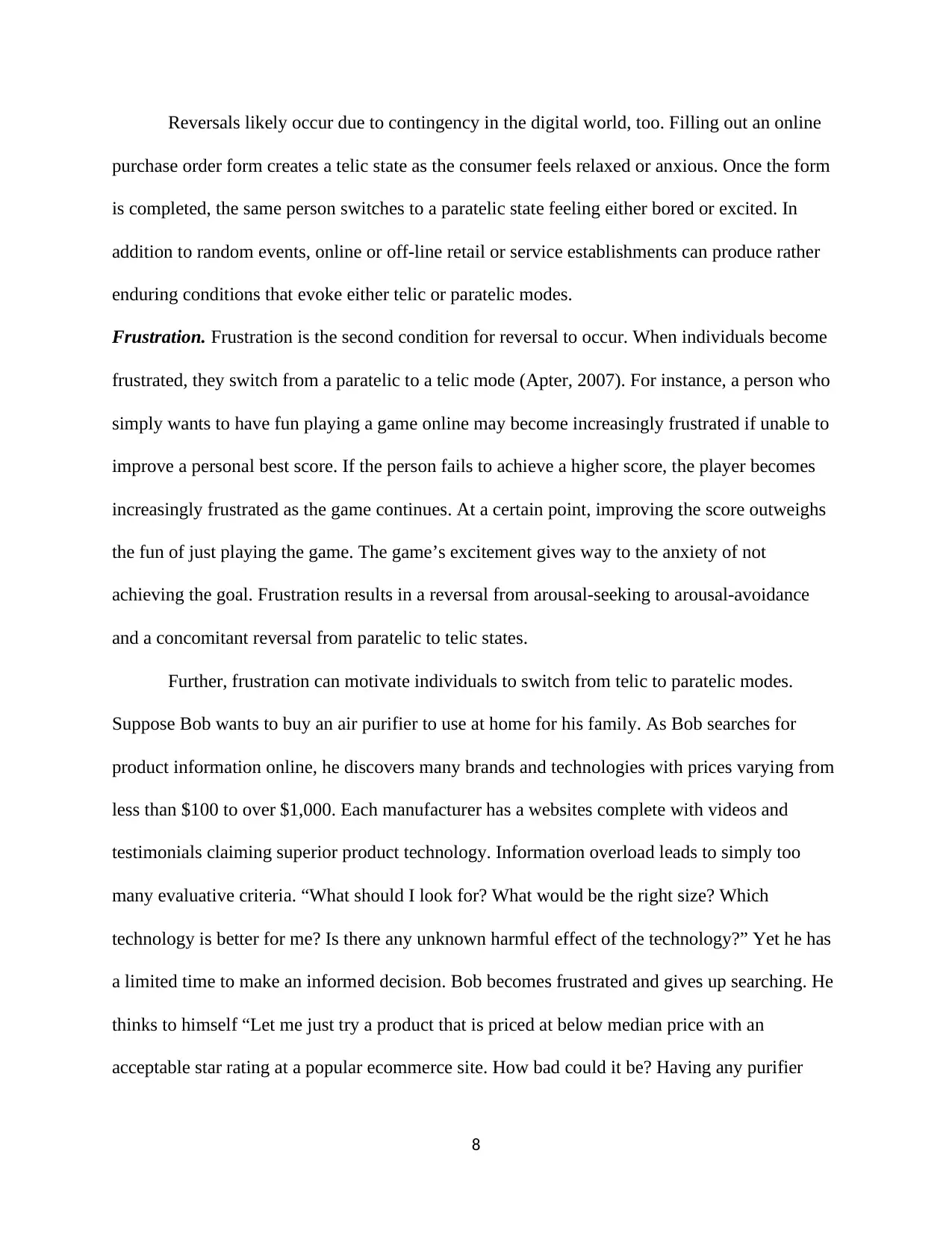
Reversals likely occur due to contingency in the digital world, too. Filling out an online
purchase order form creates a telic state as the consumer feels relaxed or anxious. Once the form
is completed, the same person switches to a paratelic state feeling either bored or excited. In
addition to random events, online or off-line retail or service establishments can produce rather
enduring conditions that evoke either telic or paratelic modes.
Frustration. Frustration is the second condition for reversal to occur. When individuals become
frustrated, they switch from a paratelic to a telic mode (Apter, 2007). For instance, a person who
simply wants to have fun playing a game online may become increasingly frustrated if unable to
improve a personal best score. If the person fails to achieve a higher score, the player becomes
increasingly frustrated as the game continues. At a certain point, improving the score outweighs
the fun of just playing the game. The game’s excitement gives way to the anxiety of not
achieving the goal. Frustration results in a reversal from arousal-seeking to arousal-avoidance
and a concomitant reversal from paratelic to telic states.
Further, frustration can motivate individuals to switch from telic to paratelic modes.
Suppose Bob wants to buy an air purifier to use at home for his family. As Bob searches for
product information online, he discovers many brands and technologies with prices varying from
less than $100 to over $1,000. Each manufacturer has a websites complete with videos and
testimonials claiming superior product technology. Information overload leads to simply too
many evaluative criteria. “What should I look for? What would be the right size? Which
technology is better for me? Is there any unknown harmful effect of the technology?” Yet he has
a limited time to make an informed decision. Bob becomes frustrated and gives up searching. He
thinks to himself “Let me just try a product that is priced at below median price with an
acceptable star rating at a popular ecommerce site. How bad could it be? Having any purifier
8
purchase order form creates a telic state as the consumer feels relaxed or anxious. Once the form
is completed, the same person switches to a paratelic state feeling either bored or excited. In
addition to random events, online or off-line retail or service establishments can produce rather
enduring conditions that evoke either telic or paratelic modes.
Frustration. Frustration is the second condition for reversal to occur. When individuals become
frustrated, they switch from a paratelic to a telic mode (Apter, 2007). For instance, a person who
simply wants to have fun playing a game online may become increasingly frustrated if unable to
improve a personal best score. If the person fails to achieve a higher score, the player becomes
increasingly frustrated as the game continues. At a certain point, improving the score outweighs
the fun of just playing the game. The game’s excitement gives way to the anxiety of not
achieving the goal. Frustration results in a reversal from arousal-seeking to arousal-avoidance
and a concomitant reversal from paratelic to telic states.
Further, frustration can motivate individuals to switch from telic to paratelic modes.
Suppose Bob wants to buy an air purifier to use at home for his family. As Bob searches for
product information online, he discovers many brands and technologies with prices varying from
less than $100 to over $1,000. Each manufacturer has a websites complete with videos and
testimonials claiming superior product technology. Information overload leads to simply too
many evaluative criteria. “What should I look for? What would be the right size? Which
technology is better for me? Is there any unknown harmful effect of the technology?” Yet he has
a limited time to make an informed decision. Bob becomes frustrated and gives up searching. He
thinks to himself “Let me just try a product that is priced at below median price with an
acceptable star rating at a popular ecommerce site. How bad could it be? Having any purifier
8
⊘ This is a preview!⊘
Do you want full access?
Subscribe today to unlock all pages.

Trusted by 1+ million students worldwide
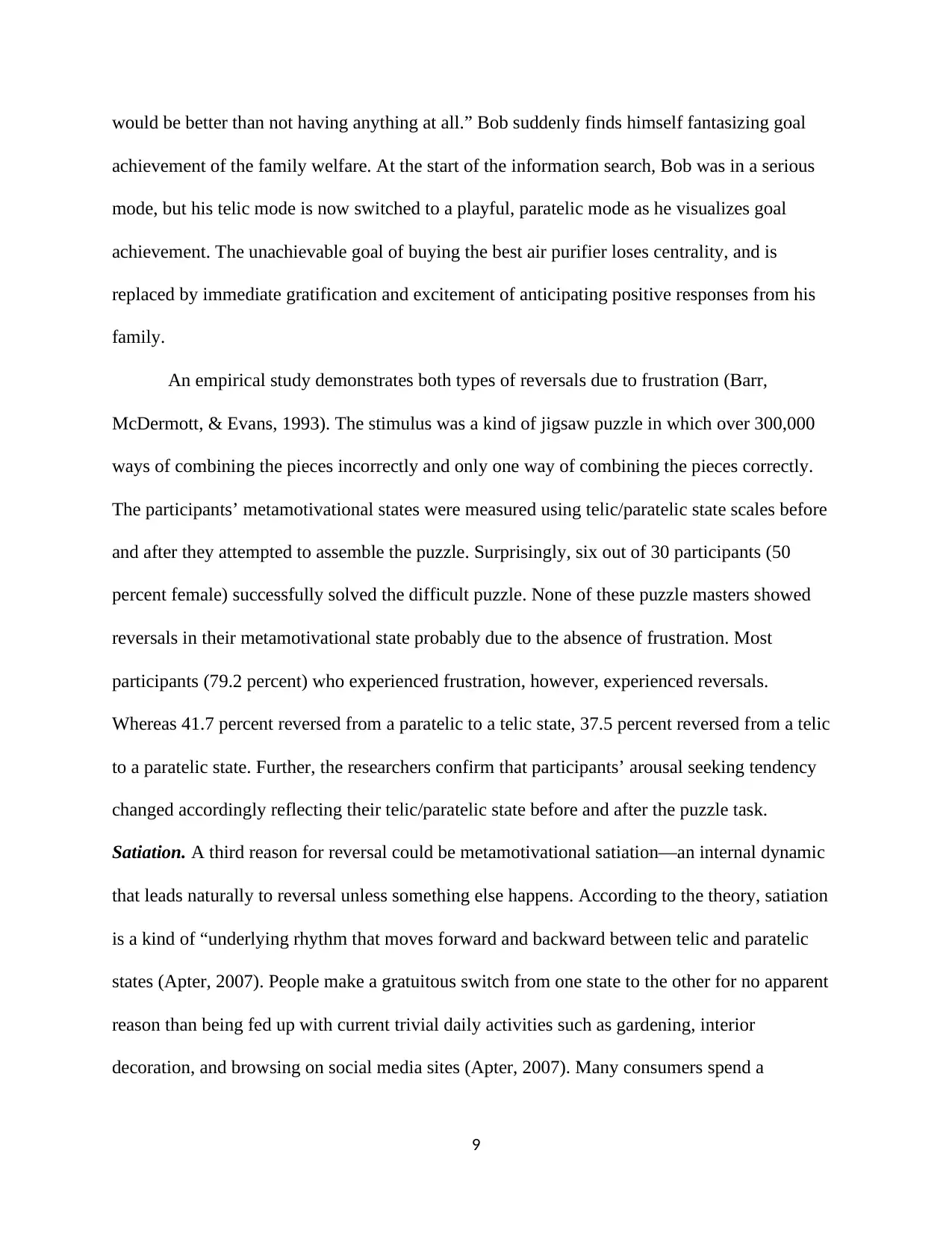
would be better than not having anything at all.” Bob suddenly finds himself fantasizing goal
achievement of the family welfare. At the start of the information search, Bob was in a serious
mode, but his telic mode is now switched to a playful, paratelic mode as he visualizes goal
achievement. The unachievable goal of buying the best air purifier loses centrality, and is
replaced by immediate gratification and excitement of anticipating positive responses from his
family.
An empirical study demonstrates both types of reversals due to frustration (Barr,
McDermott, & Evans, 1993). The stimulus was a kind of jigsaw puzzle in which over 300,000
ways of combining the pieces incorrectly and only one way of combining the pieces correctly.
The participants’ metamotivational states were measured using telic/paratelic state scales before
and after they attempted to assemble the puzzle. Surprisingly, six out of 30 participants (50
percent female) successfully solved the difficult puzzle. None of these puzzle masters showed
reversals in their metamotivational state probably due to the absence of frustration. Most
participants (79.2 percent) who experienced frustration, however, experienced reversals.
Whereas 41.7 percent reversed from a paratelic to a telic state, 37.5 percent reversed from a telic
to a paratelic state. Further, the researchers confirm that participants’ arousal seeking tendency
changed accordingly reflecting their telic/paratelic state before and after the puzzle task.
Satiation. A third reason for reversal could be metamotivational satiation—an internal dynamic
that leads naturally to reversal unless something else happens. According to the theory, satiation
is a kind of “underlying rhythm that moves forward and backward between telic and paratelic
states (Apter, 2007). People make a gratuitous switch from one state to the other for no apparent
reason than being fed up with current trivial daily activities such as gardening, interior
decoration, and browsing on social media sites (Apter, 2007). Many consumers spend a
9
achievement of the family welfare. At the start of the information search, Bob was in a serious
mode, but his telic mode is now switched to a playful, paratelic mode as he visualizes goal
achievement. The unachievable goal of buying the best air purifier loses centrality, and is
replaced by immediate gratification and excitement of anticipating positive responses from his
family.
An empirical study demonstrates both types of reversals due to frustration (Barr,
McDermott, & Evans, 1993). The stimulus was a kind of jigsaw puzzle in which over 300,000
ways of combining the pieces incorrectly and only one way of combining the pieces correctly.
The participants’ metamotivational states were measured using telic/paratelic state scales before
and after they attempted to assemble the puzzle. Surprisingly, six out of 30 participants (50
percent female) successfully solved the difficult puzzle. None of these puzzle masters showed
reversals in their metamotivational state probably due to the absence of frustration. Most
participants (79.2 percent) who experienced frustration, however, experienced reversals.
Whereas 41.7 percent reversed from a paratelic to a telic state, 37.5 percent reversed from a telic
to a paratelic state. Further, the researchers confirm that participants’ arousal seeking tendency
changed accordingly reflecting their telic/paratelic state before and after the puzzle task.
Satiation. A third reason for reversal could be metamotivational satiation—an internal dynamic
that leads naturally to reversal unless something else happens. According to the theory, satiation
is a kind of “underlying rhythm that moves forward and backward between telic and paratelic
states (Apter, 2007). People make a gratuitous switch from one state to the other for no apparent
reason than being fed up with current trivial daily activities such as gardening, interior
decoration, and browsing on social media sites (Apter, 2007). Many consumers spend a
9
Paraphrase This Document
Need a fresh take? Get an instant paraphrase of this document with our AI Paraphraser
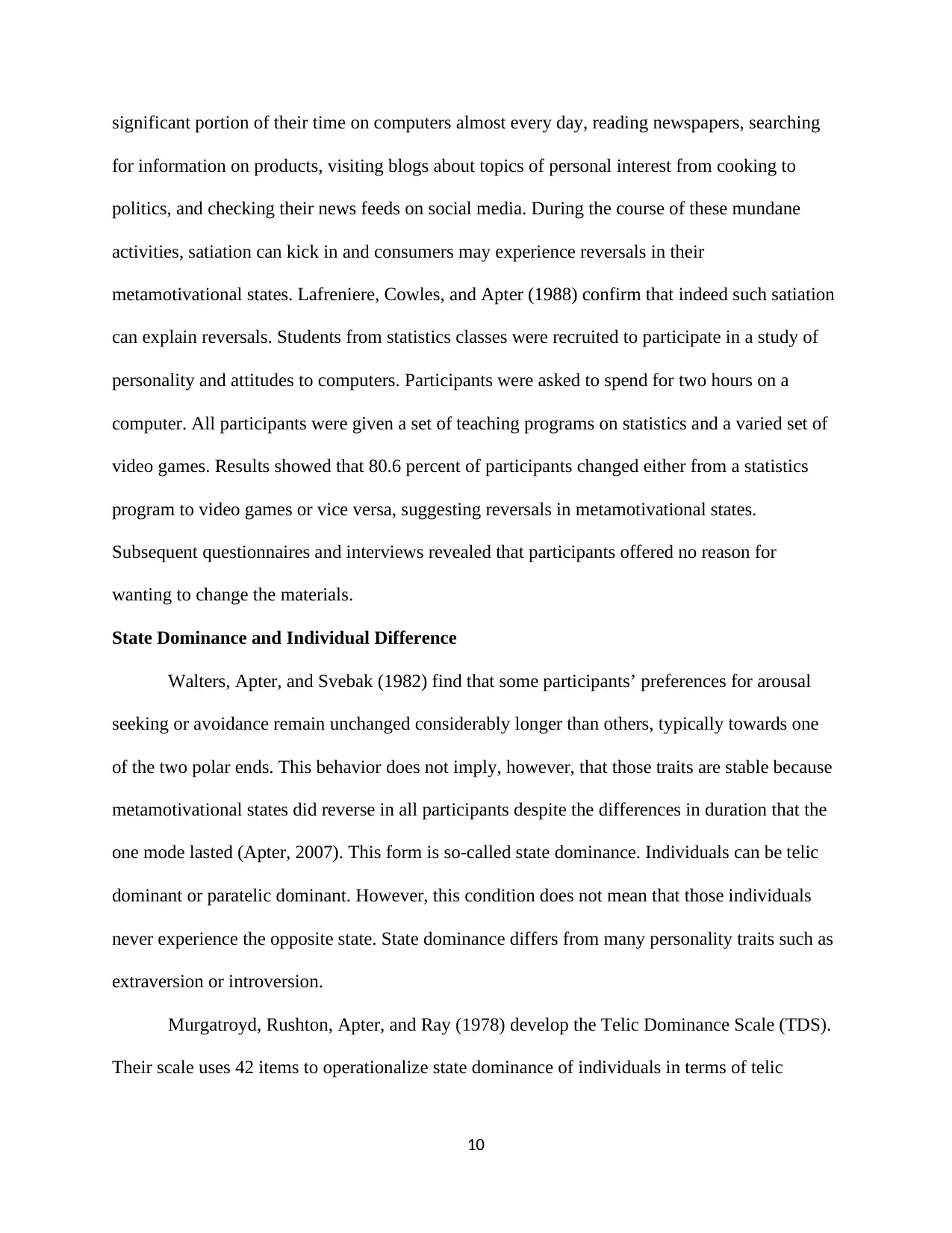
significant portion of their time on computers almost every day, reading newspapers, searching
for information on products, visiting blogs about topics of personal interest from cooking to
politics, and checking their news feeds on social media. During the course of these mundane
activities, satiation can kick in and consumers may experience reversals in their
metamotivational states. Lafreniere, Cowles, and Apter (1988) confirm that indeed such satiation
can explain reversals. Students from statistics classes were recruited to participate in a study of
personality and attitudes to computers. Participants were asked to spend for two hours on a
computer. All participants were given a set of teaching programs on statistics and a varied set of
video games. Results showed that 80.6 percent of participants changed either from a statistics
program to video games or vice versa, suggesting reversals in metamotivational states.
Subsequent questionnaires and interviews revealed that participants offered no reason for
wanting to change the materials.
State Dominance and Individual Difference
Walters, Apter, and Svebak (1982) find that some participants’ preferences for arousal
seeking or avoidance remain unchanged considerably longer than others, typically towards one
of the two polar ends. This behavior does not imply, however, that those traits are stable because
metamotivational states did reverse in all participants despite the differences in duration that the
one mode lasted (Apter, 2007). This form is so-called state dominance. Individuals can be telic
dominant or paratelic dominant. However, this condition does not mean that those individuals
never experience the opposite state. State dominance differs from many personality traits such as
extraversion or introversion.
Murgatroyd, Rushton, Apter, and Ray (1978) develop the Telic Dominance Scale (TDS).
Their scale uses 42 items to operationalize state dominance of individuals in terms of telic
10
for information on products, visiting blogs about topics of personal interest from cooking to
politics, and checking their news feeds on social media. During the course of these mundane
activities, satiation can kick in and consumers may experience reversals in their
metamotivational states. Lafreniere, Cowles, and Apter (1988) confirm that indeed such satiation
can explain reversals. Students from statistics classes were recruited to participate in a study of
personality and attitudes to computers. Participants were asked to spend for two hours on a
computer. All participants were given a set of teaching programs on statistics and a varied set of
video games. Results showed that 80.6 percent of participants changed either from a statistics
program to video games or vice versa, suggesting reversals in metamotivational states.
Subsequent questionnaires and interviews revealed that participants offered no reason for
wanting to change the materials.
State Dominance and Individual Difference
Walters, Apter, and Svebak (1982) find that some participants’ preferences for arousal
seeking or avoidance remain unchanged considerably longer than others, typically towards one
of the two polar ends. This behavior does not imply, however, that those traits are stable because
metamotivational states did reverse in all participants despite the differences in duration that the
one mode lasted (Apter, 2007). This form is so-called state dominance. Individuals can be telic
dominant or paratelic dominant. However, this condition does not mean that those individuals
never experience the opposite state. State dominance differs from many personality traits such as
extraversion or introversion.
Murgatroyd, Rushton, Apter, and Ray (1978) develop the Telic Dominance Scale (TDS).
Their scale uses 42 items to operationalize state dominance of individuals in terms of telic
10

dominance. Scale instructions ask participants to choose one of the two courses of action, telic-
versus paratelic-related actions; based on which one they would most usually prefer or most
closely apply to them. The telic dominance scale consists of three subscales, namely serious-
mindedness (14 items), planning-orientation (14 items), and arousal-avoidance (14 items).
Although these three dimensions likely correlate, they represent three distinctive phenomena. In
addition, Cook and Gerkovich (1993) develop the Paratelic Dominance Scale that consists of 30
items. These items primarily employ temporal components (e.g., “I often take risks”, “I usually
take life seriously”).
Svebak and Murgatroyd (1985) compare extremely telic-dominant individuals with
extremely paratelic-dominant individuals in in-depth interviews. Paratelic-dominant individuals
tend to be engaged in a greater variety of activities, act more flexible and spontaneous, and
appear less well-organized than telic-dominant individuals. In contrast, telic-dominant
individuals tend to execute their planned activities more carefully, spend more time carefully
monitoring their activities and performance, and show concerns about achieving their longer-
term goals. When describing the account of activities, the two groups were also quite different.
Telic-dominant individuals were detailed and described events in a more systematic way,
whereas paratelic-dominant individuals described events more generally. In addition, the two
groups differ in their language use. Telic-dominant people tended to use descriptive language,
whereas the paratelic-dominant group tended to use evaluative language (Apter, 2007).
State Balance, State Dominance, and Change
According to the reversal theory, personality is about patterns over a period of time rather
than fixated traits. Thus, individuals are flexible and change in their metamotivational states. A
consumer might spend more time in the paratelic state than in the telic state over the weekend.
11
versus paratelic-related actions; based on which one they would most usually prefer or most
closely apply to them. The telic dominance scale consists of three subscales, namely serious-
mindedness (14 items), planning-orientation (14 items), and arousal-avoidance (14 items).
Although these three dimensions likely correlate, they represent three distinctive phenomena. In
addition, Cook and Gerkovich (1993) develop the Paratelic Dominance Scale that consists of 30
items. These items primarily employ temporal components (e.g., “I often take risks”, “I usually
take life seriously”).
Svebak and Murgatroyd (1985) compare extremely telic-dominant individuals with
extremely paratelic-dominant individuals in in-depth interviews. Paratelic-dominant individuals
tend to be engaged in a greater variety of activities, act more flexible and spontaneous, and
appear less well-organized than telic-dominant individuals. In contrast, telic-dominant
individuals tend to execute their planned activities more carefully, spend more time carefully
monitoring their activities and performance, and show concerns about achieving their longer-
term goals. When describing the account of activities, the two groups were also quite different.
Telic-dominant individuals were detailed and described events in a more systematic way,
whereas paratelic-dominant individuals described events more generally. In addition, the two
groups differ in their language use. Telic-dominant people tended to use descriptive language,
whereas the paratelic-dominant group tended to use evaluative language (Apter, 2007).
State Balance, State Dominance, and Change
According to the reversal theory, personality is about patterns over a period of time rather
than fixated traits. Thus, individuals are flexible and change in their metamotivational states. A
consumer might spend more time in the paratelic state than in the telic state over the weekend.
11
⊘ This is a preview!⊘
Do you want full access?
Subscribe today to unlock all pages.

Trusted by 1+ million students worldwide
1 out of 24
Your All-in-One AI-Powered Toolkit for Academic Success.
+13062052269
info@desklib.com
Available 24*7 on WhatsApp / Email
![[object Object]](/_next/static/media/star-bottom.7253800d.svg)
Unlock your academic potential
Copyright © 2020–2025 A2Z Services. All Rights Reserved. Developed and managed by ZUCOL.